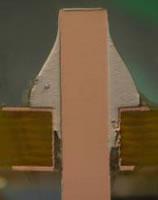Modern printed circuit assemblies are vastly complex labyrinths of interconnected devices, comprising many hundreds of components and thousands of individual signals being routed through the networks of metal, silicon, and dielectric material. While the individual integrated circuits on an assembly may steal most of the glory – just look at the buzz surrounding the processors inside the latest and greatest cell phone, video card, or supercomputer – interconnect technology is just as important to the success of a given product. To ensure a robust product, the reliability of the connections between individual components and the PCB that hosts them is paramount; to maximize this reliability, failure analysis of electronic assemblies to investigate solder failures is an excellent springboard to continuous improvement.
While failure analysis of electronic assemblies can take many forms, solder joint studies are incredibly valuable as they can provide a wealth of actionable data about the effectiveness of a given set of process parameters. Joint cracking or non-wetting, “head-in-pillow” type defects, device misalignment, and inter-metallic compound formation and characteristics are only a sample of the data that can be gleaned from this type of analysis; any of these data points provide invaluable insight into the reflow process, suggesting improvements that may be made (e.g. adjusting reflow profile times and temperatures, changing cleaning processes, even adjustments to the layout of the board to mitigate mechanical stresses). Capturing this information requires the proper application of principles and techniques; fortunately, there are a wide variety of approaches for diving into the intricacies of solder interconnects.
Perhaps the most basic (and one of the few non-destructive) approaches to failure analysis of solder interconnect is x-ray imaging. In only a few minutes of inspection time, an in-depth assessment of solder voiding and device registration can be performed. Given enough resolution, these tools are even capable of detecting gross defects (large joint cracks, missing balls on a BGA, and others) without doing any destructive analysis. Some of the most cutting edge tools can even perform tomographic scans and create three-dimensional reconstructions of an area of interest, which can then be parsed exactly as a doctor might review a patient’s CT scan to look for potential problems to target and analyze with surgical precision. Though x-ray is quick and non-destructive, it shares another similarity with medical imagery in that there is a certain degree of interpretation required to correctly identify defects. As a result, x-ray results are generally confirmed with further testing, usually destructive in nature.
One common destructive test that is generally performed on ball grid array (BGA) devices as part of an electronic assembly failure analysis where solder joint failure is suspected is dye penetrant testing. Dye penetration (colloquially referred to as “dye and pry”) involves immersing a suspect sample in a permanent dye, then subjecting the sample to vacuum to force the dye into all of the sample’s nooks and crannies. Following the vacuum exposure, the dye is allowed to dry, then the part is mechanically pried from the board, breaking all solder connections. Any air gaps that were exposed to the dye (for example, gaps left by cracked joints, head-in-pillow failures, or other non-wetting) will be readily apparent, as they will be visibly stained; good solder joints, conversely, will show no dye. Dye penetrant allows an analyst to map out all solder joints on a given device, showing trends that often translate into specific failure mechanisms (for example, large groups of cracked joints at the corners of a device may be an indicator of excessive mechanical stress). While dye penetrant allows a quick survey of all the joints on a given device, the depth of information gleaned is often limited to the location of the failing joint and where the joint failed (i.e. whether the joint cracked at an interface between solder and PCB, in the middle of the joint, etc.); for greater depth, other techniques are necessary.
Cross-sectional analysis is, in some senses, the complementary technique to dye penetrant testing. While the scope of the analysis is much more limited, with only a few joints visible in any given section, there is a much greater depth of detail that can be gleaned. After a sample is ground down and polished to reveal the joint in question, high-resolution microscopy can be used to characterize the joint and any failures therein. Thicknesses of inter-metallic compounds can be measured, solder phases can be identified, and defects like cracked or non-wetted joints can be photographed directly in-situ, rather than inferred after the fact from dye penetrant. Elemental analysis can even be used to study the admixtures of the various metals present. As mentioned, however, the cross-section is a much more targeted analysis than dye penetrant; an analyst must already know where the failure is before beginning the analysis.
Given the wide breadth of approaches to performing failure analysis of electronic assemblies where solder joint problems are suspected, choosing the proper approach is crucial in gathering actionable data. With proper planning and a methodical mindset, however, a successful investigation can generate a wealth of invaluable knowledge.


